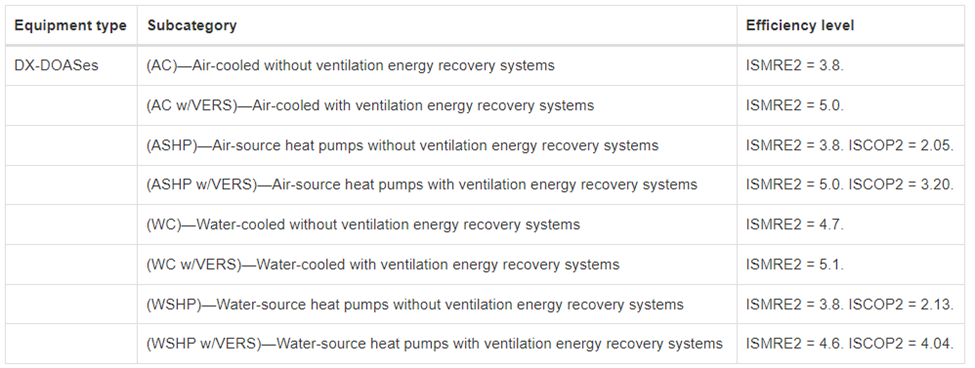Department of Energy (DOE) Efficiency Standards for Direct Expansion-Dedicated Outdoor Air Systems (DX-DOAS)
On October 31st, 2022, DOE released their final ruling concerning DX-DOAS units. DOAS units are different than other units in that their sole purpose is providing fresh outside air to the space and controlling humidity levels.
Unlike a packaged rooftop unit, a DOAS unit’s purpose is to condition the outside/ ventilation air before entering a space versus conditioning the space temperature itself. This unit ensures that fresh air is being delivered to the space at all times. A DOAS unit is set to hold a dew point temperature of 55°F for the space. This ensures also maintaining controlled humidity levels in the space as well. In their ruling, DOE mostly shares their definition of DX-DOAS with the AHRI 920 Standard. This standard is used for all DOAS rating process and lists how the units are to be tested for development. The main difference is their scope of coverage. With DOAS, the efficiency standards used are Moisture Removal Capacity (MRC) and Moisture Removal Efficiency (MRE). The DOE scope covers units with an MRC of up to 324 lb./hr. and below. This number is equivalent to about 63 tons of cooling.
DOE has also set a minimum efficiency for each type of DOAS unit that they will enforce. DOE will begin to accept unit submittals starting July 2024. They will then start to enforce their minimum requirement on May 1st, 2024.
Basic Model Groups
The basic model groups for the DOE DOAS efficiency standard, are broken down as follows:
|
With VERS |
Air Cooled |
Air Cooled |
Without VERS |
|
Air Cooled Split System |
Air Cooled Split System |
||
|
Air Source Heat Pump |
Air Source Heat Pump |
||
|
Water Cooled |
Water Cooled |
||
|
Water Source Heat Pump |
Water Source Heat Pump |
VERS - Ventilation Energy Recovery System
DOE Minimums
The DOE efficiency minimums for the different basic model groups, are outlined as follows:

ISMRE stands for Integrated Seasonal Moisture Removal Efficiency. It is a factor of the MRE values at part load cooling conditions. It is similar to IEER used in normal DX systems however this efficiency rating is only used for DOAS certified equipment. DX-DOAS equipment designed to these standards ensure that it operates efficiently, reduces energy consumption, and minimizes the overall impact on our environment. By understanding these requirements, you’re more informed when selecting units that meet or exceed these standards - ensuring long-term energy savings and compliance with industry regulations.
To find out how these latest regulations will affect AAON equipment, contact your local AAON Sales Rep.